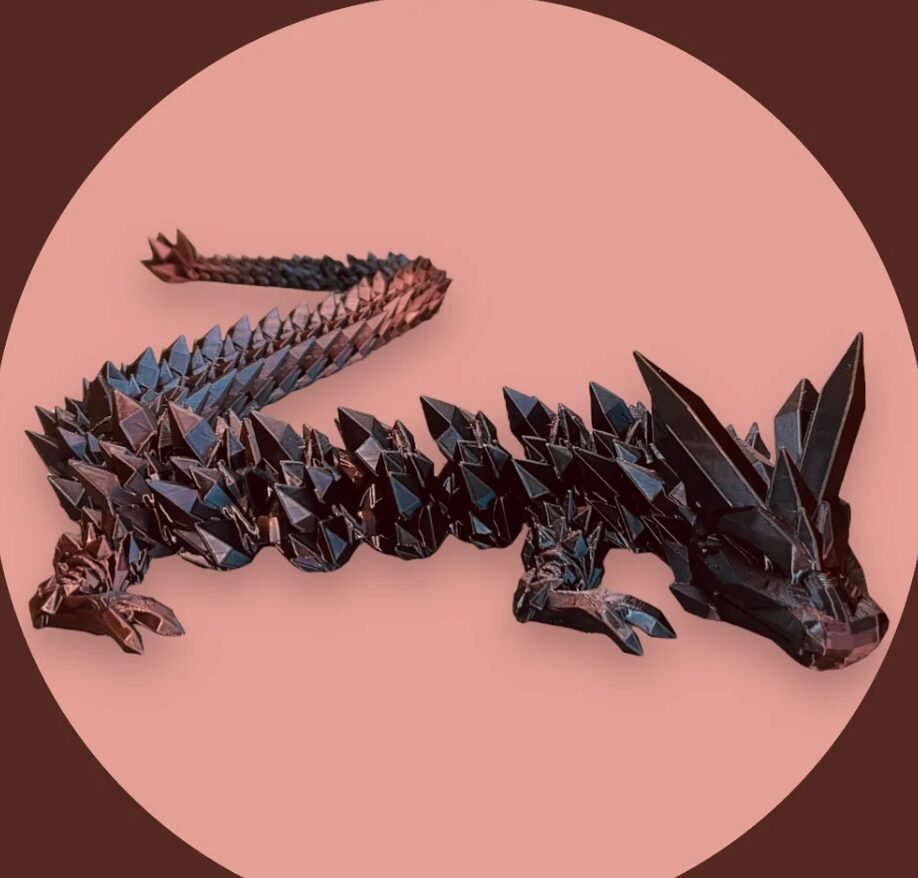In recent years, the advent of 3D printing technology has opened up a world of possibilities for creators and enthusiasts alike. Among the most captivating and intricate designs are 3D printed dragons. These mythical creatures, steeped in folklore and fantasy, have become a favorite subject for 3D printing enthusiasts. With the combination of artistic expression and technological precision 3d printed dragons have evolved into a phenomenon that captures the imagination. This article will explore the allure of 3D dragons, the process of bringing them to life through 3D printing, and their impact on various creative industries.
The Fascination with Dragons in Myth and Culture
Dragons have long held a special place in the mythology and culture of civilizations around the world. From the fearsome fire-breathing dragons of Western lore to the wise and benevolent dragons of Eastern mythology, these creatures symbolize power, mystery, and the unknown. The fascination with dragons is deeply rooted in human history, with depictions of these creatures appearing in ancient texts, artworks, and folklore.
In Western cultures, dragons are often depicted as monstrous beings, hoarding treasures and challenging heroes. These dragons embody chaos and danger, making them formidable adversaries in tales of bravery and adventure. Conversely, in Eastern cultures, dragons are revered as symbols of strength, prosperity, and protection. They are often associated with water, rain, and fertility, and are seen as benevolent guardians of the natural world.
This rich cultural heritage makes dragons an ideal subject for 3D printing. The ability to create tangible representations of these mythical creatures allows enthusiasts to connect with the legends and stories that have captivated humanity for centuries. 3D printed dragons offer a way to bring these legendary beings into the physical world, where they can be admired, studied, and enjoyed.
The Process of Designing and Printing 3D Dragons
Creating a 3D printed dragon is a complex process that requires both artistic vision and technical expertise. The journey begins with designing the dragon using 3D modeling software. Artists and designers use these tools to sculpt the dragon digitally, meticulously crafting every detail from the scales on its body to the expression on its face. This stage requires a deep understanding of both anatomy and aesthetics, as the designer must balance realism with artistic interpretation.
Once the digital model is complete, it is prepared for printing using slicing software. This software converts the 3D model into a series of thin layers, which the 3d dragons will build one by one. The slicing process also involves setting parameters such as layer height, print speed, and material choice. These settings are crucial for achieving the desired level of detail and ensuring the dragon’s structural integrity.
The printing process itself can take several hours or even days, depending on the size and complexity of the dragon. As the printer builds the model layer by layer, it brings the digital creation into the physical world. After printing, the dragon may require additional finishing steps, such as sanding, painting, or assembling multiple parts. The result is a stunning 3D dragon, a blend of artistry and technology that can be customized to reflect the creator’s unique vision.
The Appeal of 3D Printed Dragons in Popular Culture
3D printed dragons have found a prominent place in popular culture, especially within the realms of gaming, movies, and collectibles. For tabletop gaming enthusiasts, 3D printed dragons have become essential components of games like Dungeons & Dragons. These miniature dragons serve as detailed representations of characters or enemies, adding depth and immersion to the gaming experience. The ability to customize these figures allows players to bring their unique visions to life, enhancing the storytelling aspect of the game.
In the film industry, 3D printed dragons are used to create realistic props and models. The precision of 3D printing technology allows filmmakers to design dragons with intricate details that would be difficult or impossible to achieve with traditional methods. These printed models can be used for close-up shots, special effects, or even as references for digital animations.
Collectors also appreciate the unique appeal of 3D printed dragons. Artists and hobbyists create limited-edition figures, each with its own distinctive design and finish. These collectibles often become sought-after items, prized for their craftsmanship and originality. The growing popularity of 3D printed dragons in popular culture reflects the broader trend of using 3D printing technology to merge fantasy with reality, creating tangible connections to the stories and legends that inspire us.
Customizing Your Own 3D Dragon
One of the most exciting aspects of 3D printing is the ability to customize designs to suit individual preferences. This customization extends to 3D printed dragons, allowing creators to design dragons that are truly unique. Whether you want to replicate a dragon from your favorite myth, create a new hybrid creature, or experiment with different colors and textures, 3D printing provides endless possibilities for personalization.Customization begins with the design phase, where artists can alter the dragon’s pose, size, and features to match their vision. For example, you might choose to give your dragon extra-long wings, a serpentine body, or an elaborate crest. The choice of material also plays a crucial role in customization. Different materials can produce different finishes, from smooth and glossy to rough and textured. Additionally, multi-material printers allow for the creation of dragons with multiple colors or even different materials in a single print.
The ability to customize 3D printed dragons extends beyond the initial design and printing process. After the dragon is printed, it can be painted, weathered, or otherwise modified to achieve the desired look. This post-processing stage allows for further personalization, enabling creators to add details like battle scars, glowing eyes, or metallic finishes. The result is a one-of-a-kind dragon that reflects the creator’s imagination and style.
The Technical Challenges of 3D Printing Dragons
While 3D printing offers incredible creative potential, it also presents several technical challenges, especially when it comes to printing complex models like dragons. One of the primary challenges is ensuring that the fine details of the dragon, such as scales, teeth, and wings, are accurately rendered. Achieving this level of detail requires high-resolution printing, which can be time-consuming and resource-intensive.Another challenge is dealing with overhangs and supports. Dragons often have intricate shapes with parts that extend outward, such as wings or tails. These overhangs require the use of supports during printing, which are temporary structures that prevent the model from collapsing during the build. However, supports can leave marks on the final print and may require careful removal and post-processing to ensure a clean finish.Material choice also presents challenges. Different materials have different properties, and selecting the right one for a 3D printed dragon depends on the desired outcome. For example, PLA is a popular choice for its ease of use, but it may not capture the finest details as well as resin. Conversely, resin offers excellent detail but can be more challenging to work with due to its brittleness and post-processing requirements.
Despite these challenges, advancements in 3D printing technology continue to improve the quality and accessibility of 3D printed dragons. New materials, improved printers, and more sophisticated software are making it easier for creators to overcome these obstacles and produce stunning, detailed models that bring dragons to life.
The Role of 3D Printed Dragons in Education and Research
Beyond their artistic and cultural significance, 3D printed dragons also have educational and research applications. In academic settings, these models can be used to teach students about 3D printing technology, design principles, and even cultural studies. For example, a history class might use 3D printed dragons to explore the symbolism of dragons in different cultures, while a design class might focus on the technical aspects of modeling and printing these complex creatures.In the field of paleontology, 3D printed dragons can serve as educational tools to help students and the public understand the anatomy and structure of prehistoric reptiles, which often serve as the basis for dragon myths. By creating accurate models of dinosaurs or other ancient reptiles, educators can draw connections between these real creatures and the mythical dragons that they may have inspired.
Additionally, 3D printed dragons can be used in research to explore the potential applications of 3D printing technology. For instance, engineers and scientists might study the structural integrity of dragon models to develop new materials or improve printing techniques. The versatility of 3D printed dragons makes them valuable tools for both education and research, offering insights into both the past and the future.
The Future of 3D Dragons: Innovation and Possibilities
The future of 3D printed dragons is closely tied to the continued advancement of 3D printing technology. As printers become more precise and capable, the possibilities for creating ever more detailed and complex dragons will expand. Innovations in materials, such as flexible or conductive materials, could lead to the creation of dragons with articulated joints, light-up features, or even moving parts.Another exciting prospect is the integration of augmented reality (AR) and virtual reality (VR) with 3D printed dragons. Imagine using AR to project a digital dragon into your living room or using VR to explore a 3D model of a dragon before printing it. These technologies could enhance the creative process and offer new ways to interact with and appreciate 3D printed dragons.
The rise of 3D printing communities and online platforms also suggests a collaborative future for 3D dragon enthusiasts. Online marketplaces and forums allow creators to share designs, offer tips, and even sell their creations. This sense of community fosters innovation and creativity, ensuring that the art of 3D printed dragons will continue to evolve and inspire.
Conclusion
3D printed dragons represent a unique fusion of art, culture, and technology. These mythical creatures, brought to life through the precision and creativity of 3D printing, capture the imagination in ways that few other subjects can. Whether used as decorative pieces, educational tools, or collectible items, 3D printed dragons offer a tangible connection to the rich tapestry of mythology and fantasy that has fascinated humanity for millennia.
As 3D printing technology continues to advance, the possibilities for creating and customizing 3D dragons will only grow. The ability to bring these legendary beings into the physical world, to hold them in your hands and admire their intricate details, is a testament to the power of human creativity and innovation. The magic of 3D printed dragons lies not only in their form but in the limitless potential they represent—a future where the boundaries between imagination and reality continue to blur.



